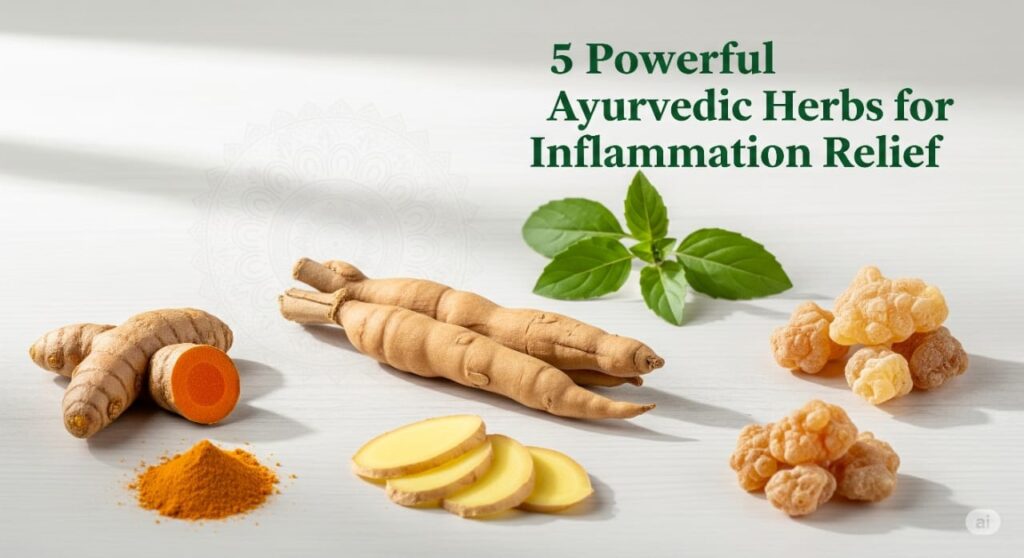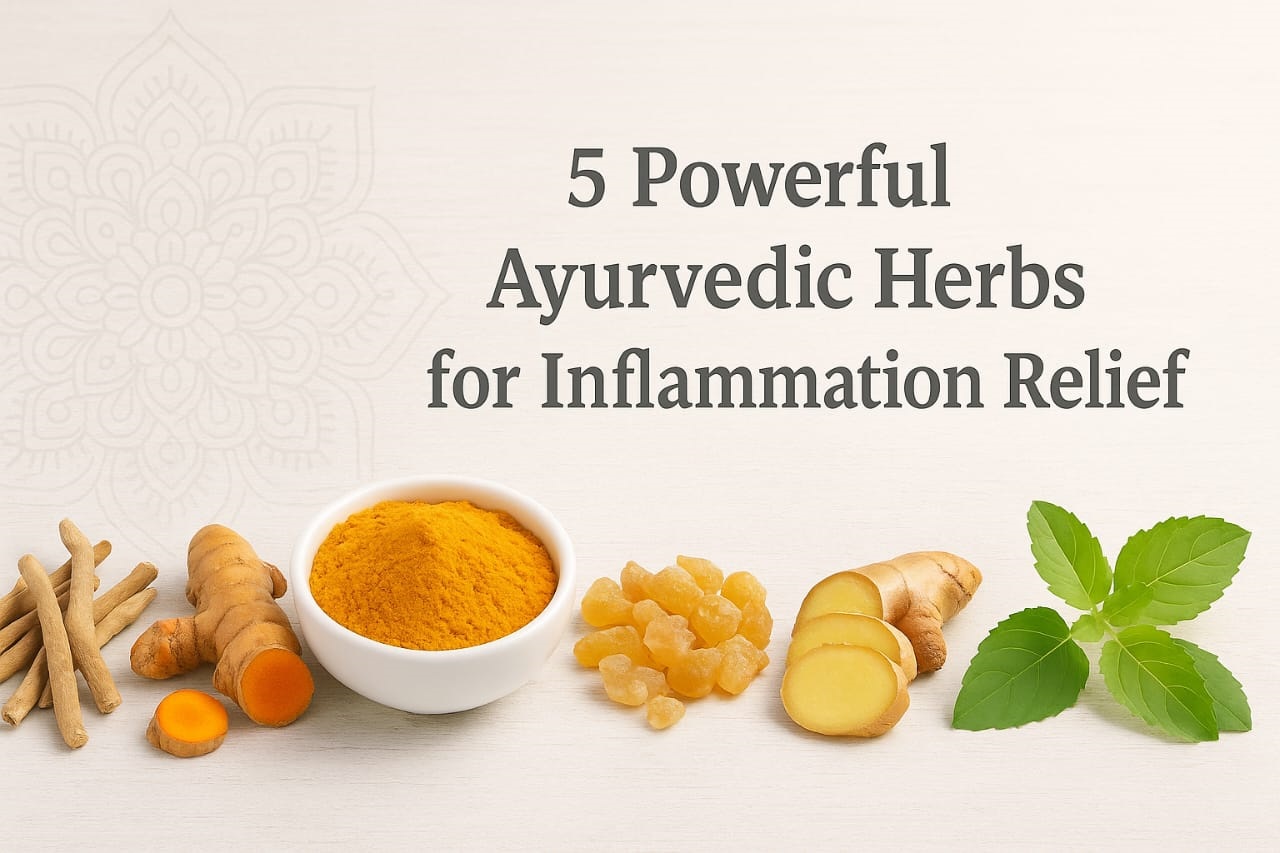Introduction
Ayurvedic herbs for inflammation Looking for a natural way to manage pain and swelling? Ayurvedic herbs for inflammation have been trusted for centuries to relieve joint pain, reduce swelling, and support chronic conditions like arthritis. Unlike conventional anti-inflammatory drugs, these time-tested herbal remedies offer gentle, long-lasting relief with minimal side effects.
Inflammation—whether acute or chronic—is a root cause of many serious health issues. Thankfully, Ayurvedic herbs for inflammation work holistically by calming the body’s immune response without harming the gut, kidneys, or heart. In this article, we’ll explore five of the most powerful Ayurvedic herbs for inflammation, backed by scientific studies and ancient wisdom. If you’re seeking safe alternatives to NSAIDs, this guide is a great place to start your journey toward natural healing.
What is Inflammation?
Inflammation is the body’s protective response to injury, infection, or harmful stimuli such as pathogens, toxins, or physical trauma. It is a natural part of the immune system’s defense mechanism and plays a crucial role in the healing process.
When the body detects a threat—like bacteria, viruses, or damaged tissue—it activates immune cells and releases chemical mediators such as histamine, prostaglandins, and cytokines. These chemicals trigger a series of reactions that increase blood flow, recruit white blood cells (WBCs), and start tissue repair. Ayurvedic herbs for inflammation are often used to support this natural healing without the side effects of synthetic drugs.
Key Signs of Inflammation (Cardinal Signs):
- Redness (Rubor) – due to increased blood flow
- Heat (Calor) – from vasodilation and increased metabolism
- Swelling (Tumor) – from fluid leakage into tissues
- Pain (Dolor) – due to nerve stimulation by chemical mediators
- Loss of function (Functio laesa) – in severe or chronic inflammation
Types of Inflammation
1. Acute Inflammation
- Duration: Short-term (minutes to a few days)
- Purpose: Protects and heals the body after injury or infection
- Examples:
- A cut or wound
- Sore throat from viral infection
- Sprained ankle
Biological Features:
- Rapid onset
- Infiltration of neutrophils (first-line immune cells)
- High vascular permeability and tissue exudation
- Ends with tissue repair and resolution
Acute inflammation is beneficial. It’s the body’s first aid response.
2. Chronic Inflammation
- Duration: Long-term (weeks, months, or years)
- Purpose: Occurs when the body fails to eliminate the cause of inflammation
- Examples:
- Rheumatoid arthritis
- Obesity-related inflammation
- Atherosclerosis
- Inflammatory bowel disease (IBD)
Biological Features:
- Slow onset
- Infiltration of macrophages and lymphocytes
- Ongoing tissue destruction and fibrosis
- Can lead to organ damage and disease progression
🔴 Chronic inflammation is harmful because it continues to damage tissues even when there is no immediate threat.
Why Does Chronic Inflammation Matter?
Chronic inflammation is now recognized as a silent contributor to many modern diseases, including:
- Type 2 Diabetes
- Cardiovascular Disease
- Cancer
- Alzheimer’s Disease
- Autoimmune Conditions
It often goes unnoticed until it causes significant damage—hence the term “silent inflammation.”
🟢 In summary:
- Acute inflammation = protective and temporary.
- Chronic inflammation = persistent and damaging.
What is Anti-inflammatory Activity?
Anti-inflammatory activity refers to the capacity of a drug, compound, or natural substance to reduce, suppress, or prevent inflammation in the body. It involves targeting key inflammatory mediators that trigger symptoms such as pain, swelling, redness, and tissue damage.
When the body encounters harmful stimuli like infection, injury, or autoimmune reactions, it releases chemical messengers such as:
- Prostaglandins
- Leukotrienes
- Histamines
- Cytokines (like IL-1, TNF-α)
These mediators increase vascular permeability, attract immune cells, and amplify the inflammatory process.
How Anti-inflammatory Agents Work
Anti-inflammatory agents work by blocking or modulating one or more of the following mechanisms:
- Inhibition of Cyclooxygenase (COX) Enzymes
COX enzymes (COX-1 and COX-2) are responsible for converting arachidonic acid into prostaglandins, which cause pain and inflammation.
Inhibiting these enzymes reduces pain, swelling, and fever. - Blocking Leukotriene Pathway
Some agents block 5-lipoxygenase, which reduces leukotriene synthesis (another pro-inflammatory pathway).
Ayurvedic herbs for inflammation like Boswellia serrata act through this mechanism. - Suppressing Cytokines
Herbal drugs and biological agents reduce the expression of inflammatory cytokines like TNF-α, IL-1β, and IL-6.
Many Ayurvedic herbs for inflammation act as natural cytokine suppressors. - Stabilizing Cell Membranes
Some anti-inflammatory drugs prevent immune cells from releasing enzymes and histamines, stabilizing mast cells and lysosomes.
Classification of Anti-inflammatory Agents
| Type | Examples | Mechanism |
|---|---|---|
| NSAIDs (Non-Steroidal Anti-Inflammatory Drugs) | Ibuprofen, Diclofenac, Aspirin | Inhibit COX enzymes |
| Steroidal Drugs | Prednisolone, Dexamethasone | Suppress immune and cytokine response |
| Herbal Medicines | Turmeric, Ashwagandha, Shallaki | Antioxidant, cytokine inhibition, COX/LOX modulation |
| Biologics | Adalimumab, Infliximab | Block TNF-α or interleukins |
Herbal Anti-inflammatory Activity
Many Ayurvedic herbs possess natural anti-inflammatory properties. They act through:
- Antioxidant mechanisms
- Inhibition of COX/LOX pathways
- Modulation of cytokines
- Stabilization of immune cells
Examples:
- Curcumin (from Turmeric) inhibits both COX-2 and TNF-α.
- Boswellic acids (from Shallaki) inhibit 5-lipoxygenase.
- Withanolides (from Ashwagandha) reduce IL-1 and TNF-α.
These herbs offer gentle, long-term support with fewer side effects compared to synthetic drugs.
Mechanism of NSAIDs: COX Inhibition
Non-Steroidal Anti-Inflammatory Drugs (NSAIDs) work primarily by inhibiting cyclooxygenase (COX) enzymes — key enzymes responsible for converting arachidonic acid into prostaglandins, which are chemical messengers that trigger:
- Inflammation
- Pain
- Fever
- Swelling
By blocking COX enzymes, NSAIDs reduce prostaglandin synthesis, thereby alleviating inflammatory symptoms.
COX-1 vs COX-2 Enzymes
There are two major types of COX enzymes:
| Enzyme | Function | Inhibition Effects |
|---|---|---|
| COX-1 | Maintains the normal function of the stomach lining, protects the kidneys, and supports platelet function | Side effects such as gastric ulcers, bleeding, and renal issues when inhibited |
| COX-2 | Induced at the site of inflammation and responsible for pain, swelling, and fever | Targeted inhibition provides anti-inflammatory and analgesic effects without affecting the stomach lining as much |
Selective COX-2 inhibitors (e.g., celecoxib) were developed to minimize gastric side effects. However, they may increase cardiovascular risks.
Common Side Effects of NSAIDs
Despite their effectiveness, long-term or high-dose NSAID use is associated with several adverse effects. This is why many patients and practitioners now consider Ayurvedic herbs for inflammation as a safer alternative, especially for chronic conditions.
Gastrointestinal Complications
Gastric ulcers, bleeding, and indigestion
Due to COX-1 inhibition, which disrupts stomach mucosal protection
Renal Toxicity
Reduced renal blood flow and kidney dysfunction
Cardiovascular Risks
Increased risk of heart attack or stroke with prolonged use of selective COX-2 inhibitors
Platelet Inhibition
Some NSAIDs may prolong bleeding time by affecting platelet aggregation

Why Choose Herbal Anti-inflammatory Agents?
Herbal and Ayurvedic medicines are gaining global attention due to their natural mechanisms, reduced toxicity, and holistic benefits.
Advantages of Herbal Anti-inflammatory Drugs:
Lower Risk of Ulcers or Renal Damage
Most herbs do not inhibit COX-1 and thus preserve gastric protection. Ayurvedic herbs for inflammation are especially known for their gastroprotective nature.
Multi-targeted Action
Many herbal compounds modulate cytokines, COX-2, and oxidative stress, offering broader therapeutic benefits. This makes Ayurvedic herbs for inflammation effective against both acute and chronic inflammatory conditions.
Safe for Long-term Use
Ideal for chronic conditions like arthritis, where NSAID use is limited due to side effects.
Better Patient Compliance
Natural origin and fewer adverse effects lead to higher acceptance.
Scientific Examples:
| Herb | Active Compound | Mechanism |
|---|---|---|
| Turmeric | Curcumin | Inhibits COX-2, TNF-α, IL-6 |
| Shallaki (Boswellia) | Boswellic acids | Inhibits 5-LOX and leukotrienes |
| Ashwagandha | Withanolides | Suppresses IL-1, TNF-α |
| Ginger | Gingerols | Inhibits prostaglandins and leukotrienes |
| Guduchi | Tinosporin | Immunomodulatory and antioxidant |
5 Powerful Ayurvedic Herbs That Fight Inflammation
Here are the most effective Ayurvedic herbs for inflammation with scientifically proven benefits:
1. Withania coagulans (Paneer Dodi)
Biological Source: Dried fruits of Withania coagulans
Family: Solanaceae
Chemical Constituents: Withaferin A, Coagulanolide, Withanolides
Mechanism of Action:
Paneer Dodi modulates the immune system and reduces the levels of inflammatory cytokines like TNF-α and IL-1β. It exhibits antioxidant and anti-arthritic effects, especially beneficial in diabetic inflammation and joint swelling.
📚 Reference: Bioactive Metabolites from Medicinal and Food Plants)
2. Withania somnifera (Ashwagandha)
Biological Source: Roots of Withania somnifera
Family: Solanaceae
Chemical Constituents: Withanolides, Withaferin A, Sitoindosides
Mechanism of Action:
Ashwagandha acts as a powerful adaptogen. It lowers cortisol levels, suppresses NF-κB signaling, and helps the body adapt to physical and emotional stress. This leads to a reduction in systemic inflammation, promotes tissue healing, and boosts immune defense.
📚 Reference: Front. Pharmacol., 22 February 2023 Sec. Ethnopharmacology Volume 14 – 2023 |
3. Curcuma longa (Turmeric)
Biological Source: Rhizomes of Curcuma longa
Family: Zingiberaceae
Chemical Constituents: Curcumin, Demethoxycurcumin, Bisdemethoxycurcumin
Mechanism of Action:
Curcumin is a well-known COX-2 inhibitor, which blocks the synthesis of prostaglandins involved in pain and inflammation. It also inhibits NF-κB, reduces oxidative stress, and supports liver detox pathways. Its effects are comparable to NSAIDs but with fewer side effects.
📚 Reference: African Journal of Biological Sciences 2024
4. Boswellia serrata (Shallaki)
Biological Source: Gum resin of Boswellia serrata
Family: Burseraceae
Chemical Constituents: Boswellic acids (especially AKBA – Acetyl-keto-β-boswellic acid)
Mechanism of Action:
Shallaki works by inhibiting 5-lipoxygenase (5-LOX) enzyme, which blocks leukotriene production. Unlike NSAIDs, it does not affect COX pathways, thus reducing inflammation without harming the gastric lining. It is highly effective in osteoarthritis and rheumatoid arthritis.
📚 Reference: Indian J Pharm Sci2011 May;73(3):255-61. doi: 10.4103/0250-474X.93507.
5. Zingiber officinale (Ginger)
Biological Source: Rhizomes of Zingiber officinale
Family: Zingiberaceae
Chemical Constituents: Gingerols, Shogaols, Paradols
Mechanism of Action:
Ginger suppresses the production of prostaglandins and leukotrienes by inhibiting both COX and LOX enzymes. It is especially helpful in muscle pain, migraine, arthritis, and digestive inflammation. Studies show its effect is comparable to ibuprofen in mild arthritis cases.
📚 Reference: sciencedirect. 2019
These Ayurvedic herbs for inflammation not only offer potent relief but also support overall immunity and healing without the side effects of synthetic drugs.
Herbal Drugs vs NSAIDs – Comparison Table
| Feature | Herbal Drugs | NSAIDs |
|---|---|---|
| Mechanism | COX/LOX inhibition, immunomodulation | COX inhibition (COX-1 & COX-2) |
| Side Effects | Minimal, well-tolerated | Common: GI ulcers, kidney damage, cardiac risks |
| Duration | Safe for long-term use | Risky for chronic use |
| Cost | Affordable, easily available | Moderate to high depending on brand/type |
| Usage Preference | Chronic inflammatory conditions like arthritis | Acute pain, fever, post-surgical inflammation |
Frequently Asked Questions (FAQ)
Q1. What causes inflammation in the body?
Inflammation is caused by the body’s immune response to injury, infections, toxins, or chronic diseases. It involves the release of chemicals like prostaglandins, histamines, and cytokines that trigger swelling, redness, and pain.
Q2. What is the difference between acute and chronic inflammation?
Acute inflammation is short-term and protective, such as after a wound or infection. Chronic inflammation is long-lasting and linked to conditions like arthritis, obesity, and diabetes.
Q3. How do Ayurvedic herbs reduce inflammation?
Ayurvedic herbs for inflammation work by modulating immune responses, inhibiting COX and LOX enzymes, and reducing the production of inflammatory mediators such as prostaglandins and leukotrienes.
Q4. Are herbal anti-inflammatory drugs safer than NSAIDs?
Yes, most herbal anti-inflammatory agents are safer and better tolerated than NSAIDs. They have minimal side effects and are suitable for long-term use, unlike NSAIDs which may cause gastric ulcers, kidney issues, or cardiovascular risks.
Q5. Can Ayurvedic herbs be taken with NSAIDs?
In some cases, yes. However, combining Ayurvedic herbs for inflammation with NSAIDs should be done under the supervision of a healthcare provider to avoid interactions or excessive suppression of inflammation.
Q6. Which is the best Ayurvedic herb for joint pain?
Boswellia serrata (Shallaki) and Turmeric (Curcuma longa) are among the best Ayurvedic herbs for joint pain due to their strong anti-inflammatory properties and COX/LOX inhibition mechanisms.
Conclusion: Choose Ayurvedic Herbs for Natural Inflammation Relief
Inflammation is a double-edged sword — essential for healing, yet harmful when it becomes chronic. While NSAIDs are effective, their long-term use often brings side effects like ulcers, kidney damage, and heart issues.
On the other hand, Ayurvedic herbs for inflammation—such as Turmeric, Ashwagandha, Boswellia, and Ginger—offer a safer, holistic alternative. These time-tested herbs have been scientifically validated for their ability to reduce inflammation, support immunity, and promote overall wellness.
If you’re aiming to manage inflammation naturally, incorporating these herbs under professional guidance can make a significant difference in chronic conditions like arthritis, IBS, or metabolic syndrome.
👉 For more Ayurvedic and pharmacy-based health insights, explore our Charak Samhita and Ayurveda article.
🎥 Don’t forget to subscribe to our YouTube channel: Pharmacy Professor Official
Disclaimer
The information provided in this article is for educational and informational purposes only. It is not intended as a substitute for professional medical advice, diagnosis, or treatment. Always consult a qualified healthcare practitioner or Ayurvedic doctor before starting any Ayurvedic herbs for inflammation or any other herbal supplement, especially if you are pregnant, nursing, or taking medications.
The herbs and studies mentioned are based on published research and traditional Ayurvedic practices related to Ayurvedic herbs for inflammation and other health conditions. Results may vary from person to person. Neither the author nor PharmacyProfessor.com is responsible for any adverse effects resulting from the use of the information provided.

